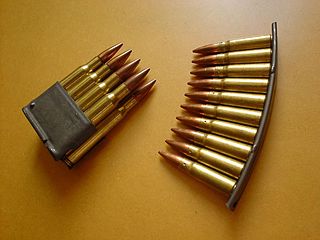
A revolver is a repeating handgun with at least one barrel and a revolving cylinder containing multiple chambers for firing. Because most revolver models hold up to six cartridges, before needing to be reloaded, revolvers are commonly called six shooters or sixguns. Due to their rotating cylinder mechanism, they may also be called wheel guns.

Mauser, originally the Königlich Württembergische Gewehrfabrik, was a German arms manufacturer. Their line of bolt-action rifles and semi-automatic pistols was produced beginning in the 1870s for the German armed forces. In the late 19th and early 20th centuries, Mauser designs were also exported and licensed to many countries, which adopted them as military and civilian sporting firearms. The Gewehr 98 in particular was widely adopted and copied, becoming one of the most copied firearms designs and it is the foundation of many of today's sporting bolt-action rifles. Around 10 millions Gewehr 98 style rifles were produced.

The M1903 Springfield, officially the U.S. Rifle, Caliber .30, M1903, is an American five-round magazine-fed, bolt-action service repeating rifle, used primarily during the first half of the 20th century.

A semi-automatic pistol is a repeating handgun that automatically ejects and loads cartridges in its chamber after every shot fired, but only one round of ammunition is fired each time the trigger is pulled. The pistol's fire control group disconnects the trigger mechanism from the firing pin/striker until the trigger has been released and reset manually, unlike the self-cycled firing mechanism in fully automatic pistols.

Webley & Scott is an arms manufacturer founded in Birmingham, England. Webley produced handguns and long guns from 1834 to 1979, when the company ceased to manufacture firearms and instead turned its attention to producing air pistols and air rifles. In 2010 Webley & Scott restarted the production of shotguns for commercial sale.

.22 short is a variety of .22 caliber rimfire ammunition. Developed in 1857 for the first Smith & Wesson revolver, the .22 rimfire was the first American metallic cartridge. The original loading was a 29 or 30 gr bullet and 4 gr of black powder. The original .22 rimfire cartridge was renamed .22 short with the introduction of the .22 long in 1871.

A clip is a device that is used to store multiple rounds of ammunition together as a unit for insertion into the magazine or cylinder of a firearm. This speeds up the process by loading the firearm with multiple rounds simultaneously, rather than individually, as with loose rounds of ammunition. There are several types, most made of inexpensive stamped sheet metal, generally they are intended to be disposable, but they are more often retained and reused.

Stevens Arms is an American firearms manufacturer founded by Joshua Stevens in 1864 in Chicopee, Massachusetts. The company introduced the .22 Long Rifle round and made a number of rifle, shotgun, and target pistol designs. By 1902, they were advertising themselves as "the largest producers of sporting arms in the world". They were purchased by New England Westinghouse on May 28, 1915, and again by Savage Arms on April 1, 1920. As a division of Savage, Stevens continued to produce firearms at their Chicopee Falls facility until 1960 when the plant was torn down and Stevens production was moved into other Savage facilities. Savage dropped the Stevens name in 1991, but revived it in 1999 and still uses it today for a number of its low cost rifles and shotguns.

The Colt New Model revolving rifles were early repeating rifles produced by the Colt's Manufacturing Company from 1855 until 1864. The design was essentially similar to revolver type pistols, with a rotating cylinder that held five or six rounds in a variety of calibers from .36 to .64 inches. They were mainly based upon the Colt Model 1855 Sidehammer Pocket Revolver developed by Elisha K. Root. Colt revolving pistols and rifles were attractive mainly because of their high rate of fire. They were used to a limited extent on the Pony Express and made a brief appearance in the American Civil War. However, the rifles were generally disliked by soldiers, and were ultimately discontinued due to serious design flaws.
The evolution of German military rifles is a history of common and diverse paths followed by the separate German states, until the mid-19th century when Prussia emerged as the dominant state within Germany and the nation was unified. This article discusses rifled shoulder arms developed in or for the military of the states that later became Germany; it excludes firearms of the Austrian Empire, except where they were used substantially by German troops.
The Vetterli rifles were a series of Swiss army service rifles in use from 1869 to 1889, when they were replaced with Schmidt–Rubin rifles. Modified Vetterlis were also used by the Italian Army.

The 7.65×25mm Borchardt cartridge was designed by Georg Johann Luger for use in Hugo Borchardt's Borchardt C-93 pistol. It was the first successful rimless pistol cartridge.

The Mauser Model 1889 is a bolt-action rifle of Belgian origin. It became known as the 1889 Belgian Mauser, 1890 Turkish Mauser, and 1891 Argentine Mauser.
Davide Pedersoli & C. is an Italian firearms manufacturing company based in Gardone Val Trompia, Italy, that was founded in 1957 by Davide Pedersoli.

The Bushmaster Arm Pistol was a 5.56×45mm NATO firearm, categorizeable as either a long pistol or compact carbine rifle, produced by the Gwinn Firearms Company, and later Bushmaster Firearms Inc. The firearm was a new design, having a rotating bolt combined with a long stroke gas piston system similar to the AK-47 rifle.
The Podewils rifle-musket was a 13.9mm calibre rifle used in the Bavarian army since 1858. It was the most common infantry weapon of the Bavarian army in the Austro-Prussian war of 1866 and the Franco-Prussian war of 1870/71. Theodor Fontane called it an "excellent" weapon of the Austro-Prussian war due to its long range. Originally a muzzleloader, it was converted to breechloading in 1867, the so-called Lindner conversion. In 1869 the Bavarian army started to replace it with the Werder breechloader, but due to budgetary constrains by 1870 most Bavarian troops still used the Podewils while only four infantry battalions had received the Werder. Even the Lindner conversion was inferior to both the Prussian Dreyse needle gun and the French Chassepot.












